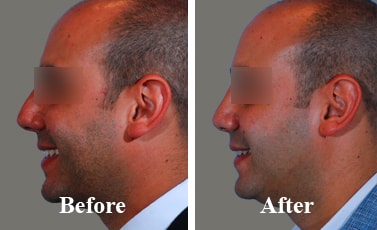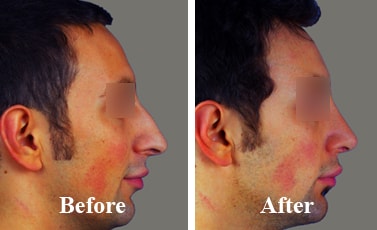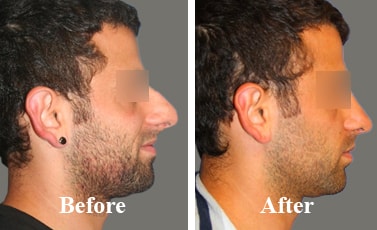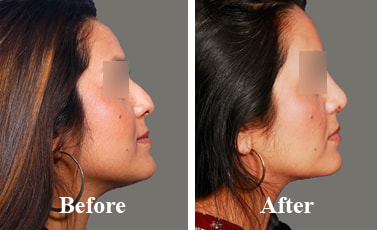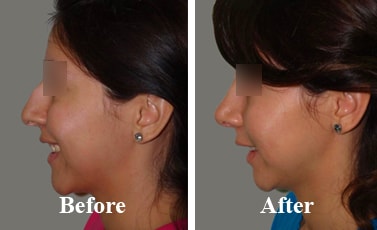Reshape Your Nose As You Want
Best Rhinoplasty Surgeon in India Get Your Nose Reshaped from Best Surgeon!
Rhinoplasty Surgery Clinic in India - Rhinoplasty, sometimes referred to as a "nose reshaping" or "nose reshaping" by patients is a aesthetic surgery procedure for correcting and reconstructing the form, restoring the functions, and aesthetically enhancing the nose. Most patients ask to remove a bump, narrow nostril width, change the angle between the nose and the mouth, as well as correct injuries, birth defects, or other problems that affect breathing. Find the best Rhinoplasty Clinic in India.
[forminator_form id="42596"]
CALL NOW & GET DISCOUNT: 8329060384
Free Consultation, Best Treatment, Lowest Cost, Easy Finance Available, 100% Result
Rhinoplasty Surgery Cost in India Know the Cost of Nose Job, Deals & Offers in India
Rhinoplasty Cost Depends on?
Nose surgery costs in India - Rhinoplasty surgery costs can vary widely. The cost of Rhinoplasty Surgery depends on Anesthesia fees, Hospital or surgical facility costs, Medical tests, Post-surgery garments, Prescriptions for medication, Surgeons fee, Clinic stay etc. A surgeons fee will be based on his or her experience and geographic office location. When choosing a board-certified aesthetic surgeon in your area for a rhinoplasty procedure, remember that the surgeons experience and your comfort with him or her are just as important as the final cost of the surgery.
Fill the form to know the approx cost of Nose surgery for your case in India.
[forminator_form id="42596"]
Contact Us
[forminator_form id="42596"]
Find detailed information about Rhinoplasty, Side Effects, Pre-Post Procedure Care, FAQs & Choose a Rhinoplasty surgeon you can trust in India. If you are a Surgeon from India, you are most welcome to join our network & If you are looking for Rhinoplasty you can find doctors, Ask your doubts about Rhinoplasty or read the blogs. We have tried to list best Clinics, doctors & surgeons in & near India. Please fill the form to schedule your free consultation with one of our affiliate clinic in India. To know the approximate cost of Rhinoplasty Procedure, click on - http://www.rhinoplastysurgery.co.in/cost-financing/.
The information provided by this site is meant for general purposes only and should not be seen as a substitute to advice from medical doctors. Do not take it as a treatment guide. Do consult your physician as different cases demand different attention. We do not claim information provided here to be of professional nature. If anything goes wrong with anyone acting upon information provided on the site, Rhinoplastysurgery.co.in won’t responsible for it. The photos seen on the site are for the purpose of representation only. Results of surgeries differ greatly from patient to patient and can’t be guaranteed.
The art of sculpting the nose
Noses that are at times too large or too small or those that are twisted or have unwanted bumps and humps or those that have been impaired by physical injury can be corrected through a surgical process known as rhinoplasty. The word "Rhinos" is the Greek word representing nose and "plastikos" means to shape. So, simply rhinoplasty means "shaping the nose." Undoubtedly, the nose is the most essential facial characteristic. Therefore, a modest nasal adjustment can have a great impact in improving one's appearance. A rhinoplasty is supreme for patients who wish to enhance the aesthetics of their nose. Rhinoplasty can decrease or increase the size of the nose. It can enhance the shape of the nasal tip or bridge. It can shorten the span of the nostrils or improve the angle located between the nose and upper lip.
Who to consider Rhinoplasty?
Usually, a rhinoplasty patient is a person who has been reasonably unsatisfied with a particular characteristic of his or her nose. This person has usually been unhappy for a long period of time. Candidates for rhinoplasty surgery include men, women, teenagers, adolescents, adults and seniors citizens.
Few people realize it, but as we grow old, the cartilage within our nose expands. The nose grows bigger and it can remarkably droop or become asymmetrical in shape. One of the symptoms of facial aging in some people is the adjustment of nasal appearance. It is not unusual for me to perform a rhinoplasty simultaneously as a facelift in a patient whose main reason for wanting surgery is to look younger.
Generally, patients who come to doctors for aesthetic rhinoplasty complain about noses that are:
- Too long
- Have a hump or bump
- Too thick at the bridge or tip
- Or those that have other deformities
- Are crooked or hooked
A rhinoplasty is the method of choice for patients who have complications in breathing. This process may help them breathe more normally and regularly. Troubled breathing can be affected by a distressing nasal fracture or by functional malformation. Health insurance ordinarily covers rhinoplasty medical procedures for those cases because they are viewed as being medically mandatory. A certain type of rhinoplasty used to treat functional nasal breathing disproportion problems is called the septo-rhinoplasty. This procedure involves the dismissal of any inside obstructions. A septo-rhinoplasty also involves the correction of any functional deformities that may block nasal breathing as well as those abnormalities which enable too much air to enter the nasal cavity.
Most rhinoplasty procedures, although, are executed for aesthetic reasons and are therefore not eligible for insurance reimbursement. Aesthetic procedures are not protected by health insurance. Even so, researchers have found that these procedures are still prized and admired by patients. This accompanying change in appearance often results in an increment in self-confidence and in overall happiness and satisfaction of the patient.
About half of aesthetic rhinoplasties require functional correction simultaneously. If a septoplasty or internal valvular rebuilding is not performed at the time of aesthetic rhinoplasty, and it is pointed out, then these patients, who might have had marginal breathing before the procedure, will have damaged nasal breathing after aesthetic rhinoplasty.
It is not unusual for me to see a mid-teen boy or a girl, brought in by their parents, asking nasal surgery. A large or otherwise unappealing nose can be quite enfeebling for the personality of a young person. This facial characteristic can even form a social hermit. In these patients, a rhinoplasty can be a life-changing procedure. The surgery can transform a weird, social recluse into a more self-confident,outgoing and overall happier teen.
There Is No replacement for an Experienced Board-Certified Aesthetic Surgeon or specialist.
Regrettably, along with the rise in popularity of rhino-plasty, there has been an increase in the number of unprofessional surgeons that perform this procedure. According to a current New York Times article, there has been a corresponding increase in the necessity for, and the number of remedial revision surgeries or "re-dos."
The point to take here with you is that surgical experience with nasal surgery genuinely counts with this kind of surgery. In the hands of experienced, Board-Certified aesthetic specialists and ENT specialists, the larger part of rhinoplasty strategies can bring about an enhanced appearance and in enhanced nasal relaxing. Tragically, the same can't be said for strategies performed by less experienced or less gifted specialists. That is the reason, on the off chance that you need the best shots for progress, it is better for planned patients to pick a Board-Certified aesthetic specialist, one who has the experience, specialized aptitudes, and intrinsic aesthetic vision to accomplish the coveted outcome.
All things considered, you are entrusting your face to your aesthetic specialist. You deserve to contract the specialist who is most experienced and generally qualified. To find that paragon, patients ought to request referrals from their family doctor or internist. Attempt to get referrals from companions and relatives who have had fruitful rhinoplasty systems. Patients should then get second or even third sentiments from Board-Certified aesthetic specialists in regards to the need and degree of the nasal medical procedure required for your situation.
When you are in the specialist's office, don't be bashful about making inquiries. Ask to take a photo at "previously, then after the fact" photographs of the specialist's previous patients. Approach the workplace for the names and telephone quantities of previous patients who have consented to discuss their careful encounters. When you talk with these previous patients, clarify that you are thinking about having "a nose work" and that you would value their assessment. Try not to be hesitant to get some information about whether their desires were met by the specialist who did their medical procedures. Request that these previous patients share their contemplations and sentiments with you from everything to the underlying counsel to their post-agent mind.
Furthermore, before you settle on your official conclusion to contract a aesthetic specialist, check to decide whether he or she is Board-Certified by the American Board of Aesthetic Surgery. This "Blessing" shows that the specialist has experienced a thorough preparing, training and testing process. This affirmation likewise demonstrates that the specialist's case comes about have been surveyed and endorsed of by her Board-Certified associates.
What about revision surgery?
If that you are an individual from the small, but developing level of patients who require a "re-do," consider hiring another authority . . . one who is expert at what is called update rhinoplasty medical procedure. A little gathering of to a great degree gifted and capable aesthetic specialists are currently centering a bigger piece of their consideration and aptitudes on helping such patients. Try not to be hesitant to ask the specialist to whom you have been eluded whether he or she has broad involvement in modification nasal medical procedure.
The most ordinary reasons for a revision rhinoplasty include substandard tip definition, contour irregularities in the tip or dor-sum, overall esthetic disparity. When I perform revision nasal surgeries that require the inclusion of native tissue, I use cartilage grafts obtained from the ear, septum or rib cartilage.
Genuine assumptions are the key to patient satisfaction
Actually, I play out a great deal of rhinoplasty medical procedures on patients who have been referred to me. I have discovered that one key to the accomplishment of a rhinoplasty, particularly a rhinoplasty modification medical procedure, is the underlying exchange with the patient about what result is normal. Unpractised specialists frequently don't understand the significance of this factor. As a rule, they don't set aside the fundamental opportunity to counsel with their patients in regards to desires. Then again, the most skilled and experienced of every single aesthetic specialist may not perceive the significance of setting aside the opportunity to comprehend their patients' coveted results.
Truth be told, experienced aesthetic specialists can enable their patients to create sensible result desires. They do that in a few ways. One path is by examining with the patients their vision of how they need their nose to look like after the medical procedure. This pre-agent discourse focuses on specifics, not sweeping statements.
I also help my patients to visualize the best possible outcomes that are possible by taking digital photographs of their facial expressions. Next, I use computerized software to exploit the photos to advance a series of images that show how their post-operational nose can look.
Preoperative photograph:
This patient has a badly defined nasal tip and disharmony of all of the nasal parts.
Post-operative photograph:
She had a rhinoplasty performed with displacing of all nasal elements in such a way as to create a beautiful, more of a natural look. This patient also had neck liposuction performed.
Rhinoplasty is a comparatively painless out-patient operation
Almost every rhinoplasty patient asks how much pain and discomfort she or he should anticipate. I describe that rhinoplasty operations are normally out-patient procedures which, if done appropriately, lead to much less pain, swelling, or discomfort. Correct care includes a rigorous pre-surgical assessment of the patient's general and physical health and preoperative laboratory studies.
Patients who are smokers, former smokers and those with diabetes or cardiovascular problems show unique problems. In general, these kinds of patients can have rhinoplasty surgery if they are still in good well-being, but the surgeon must be cautious about and capable of identifying and dealing with potential problems associated with the risk factors involved.
Provisions should be taken for protections. For example Smokers, must be encouraged to quit or at least reduce the number of cigarettes consumed in a day, week or month. This precautionary step can immensely help reduce postoperative coughing and bleeding. Diabetic patients should ensure their blood sugar levels are within its normal levels. Their blood sugar levels should be monitored before and after the surgical procedure.
Every patient must be strictly advised that no food or liquids should be consumed within six hours prior to the operative procedure. A patient should not drink water, even chew gum or even eat candy. This is because if there are stomach contents present, the difficulty rate may increase. Another safeguard is the preventative cautioning with respect to staying away from headache medicine and all blood thinners. None of these blood thinners ought to be taken inside 10 to 14 days preceding medical procedure since they will support draining and wounding. Since numerous over-the-counter items contain ibuprofen or blood thinners, it is imperative to check all prescriptions deliberately. Indeed, even multi-vitamins are forbidden due to the nearness of Vitamin E (an intense blood-more slender) in most multi-vitamins.
Different medications to be dodged incorporate non-steroidal mitigating meds, (for example, Advil, Motrin, and Naprosyn). These prescriptions ought not to be taken inside ten to fourteen days of a rhinoplasty. On the off chance that you are in question ¡X in the event that you have any inquiries with respect to the prescriptions that you take, please call your aesthetic specialist's office or counsel your drug specialist
In my grasp the rhinoplasty surgery as a rule takes one to two hours, contingent upon the unpredictability of the case. It is generally performed at an outpatient medical procedure focus. No overnight stays are required. An anaesthesiologist is available to screen indispensable capacities all through the methodology. More often than not, the anaesthesiologist calls the patient the prior night medical procedure to audit the patient's medicinal history.
Rhinoplasty can be performed under a general or neighbourhood analgesic, contingent upon the patient's or specialist's inclination. On account of the requirement for anaesthesia, I generally demand that another person drive the patient home after the method and urge the patient to have somebody remain overnight the day of medical procedure in case of unanticipated inconveniences. Post-rhinoplasty (after rhinoplasty) complexities are very exceptional. The aesthetic specialist must be fit to perceive any potential difficulties and be able to treat them. A portion of the known entanglements of rhinoplasty medical procedure incorporate nasal dying, disease, breathing challenges and outer (situated outside) unmistakable nasal inconsistencies. Aesthetically, the most well-known difficulties after a rhinoplasty are poor tip definition and supra tip scarring which yields a general ineffectively characterised nose.
One of the feelings of dread communicated by potential rhinoplasty patients is that their noses should be awkwardly pressed with bandage to forestall post-agent dying. I calm such patient feelings of trepidation by setting particular sutures inside the nose which avoids intemperate draining and in this way makes bandage pressing pointless.
As a feature of our typical post-operative mind, rhinoplasty patients wear a little nasal support for five-to-seven days after the technique. Since the brace goes about as a help and a defensive structure, it really improves quiet solace. Some swelling and wounding is normal, in spite of the fact that it ought to be gentle.
Most patients report that their post-operative discomfort is generally mild. I recommend rather mild medication for pain relief. Some patients only take Tylenol.
Finish recuperating and the settling of the nose into its last wanted frame ordinarily takes from between six to nine months. As far as I can tell, most patients look satisfactory and can come back to work without torment or uneasiness inside 7 to 10 days after the methodology. Most patients come back to some direct type of activity inside 10 days after medical procedure. I permit contact wears after around 2 months. At that point, the nasal structures have mended enough to withstand any coincidental damage.
Preoperative photograph:
This patient has a comparatively small nose to start with. She also has fine facial charecteristics.
Post-operative photograph:
Subtle changes of her nose created more nasal definition and better nasal proportions. The medical procedure eventually resulted in an overall more pleasing appearance.
In a nutshell, a successful rhinoplasty requires a talented,skilled and experienced Board Certified aesthetic surgeon that can assess an individual patient's anatomy accurately as well as the patient’s expectations. Hopefully this same specialist will be capable of producing the desired aesthetic results.
Recovering from a rhinoplasty FAQ
How long do you think should I take off from work, school, etc. to heal properly?
We recommend minimum 1 week of physical rest after the surgical procedure is completed. This will allow adequate time for your body to focus on healing immediately and properly after the procedure without any demands. Preferably, another week would help to slowly ease the body to return to normal activities and permit for possible social downtime such as bruising and swelling.
What medications will I be provided; which pain medications do you commonly prescribe?
We normally prescribe 1) pain medication to minimize discomfort,2) antibiotics (to prevent infection), 3)antnausea medication
Every person has a distinct medical hex and we consider all of this prior to dispensing medication. The antibiotics help to save an infection from growing and are taken after the surgery. Majority of our patients have mild to moderate discomfort that is usually manageable through oral pain medications and exercises. Some patients may feel nausea throughout the recovery process and medications will help to reduce this.
What tips do you suggest to ease some discomfort and pain?
Adequate rest is the number one most essential part of the healing process. Pain is highly personalised and we all have a distinct perception of pain in conjunction with difference in process requirements. Is it tremendously rare that we have patients who are in notable pain and will always address this ensuring that they are comfortable?
Must I follow any particular diet, both preoperatively and postoperatively?
We encourage our patients to have a healthy diet. Nutrition is a key element to facilitate wound healing and is a non-negotiable. Enough amounts of vitamins, minerals, protein and necessary fatty acids are the building blocks for our body. The healthier the patient, the faster will be the recovery process. We also advise a low sodium diet 1 week before and during recuperation which can help to minimize the amount of fluid retained which can enhance swelling.
How long after the surgery will I be able to work out, run, or participate in sports activities?
Physical activity may be started off 3 weeks after surgery. This is to allow adequate time for your body to recuperate while minimizing the amount of swelling,bruising or possible bleeding. We will follow you closely after your process to assess your recovery and inform you when you can resume workout once again.
How can you be sure to choose the best rhinoplasty surgeon in India for you?
First of all you need to choose a surgeon whom you can trust
It can be hard to know who may be the best rhinoplasty surgeon for you. Follow the recommendations of a good consultant and you’ll find a qualified rhinoplasty surgeon.
There is no real answer to this question that who is the best surgeon for different patients. Choosing a specialist is a personal decision also that depends on your feelings as well. You may and should choose the surgeon you feel most comfortable with. You and your surgeon should agree on expectations and goals. You must be careful as you are placing your rhinoplasty operation success in their professional hands. Make sure you find a surgeon you are comfortable with.
You should take enough time to make sure that get the best satisfaction and happiness as you desire at the end of your medical procedure. Select that surgeon that you can have trust on.
What makes a good nose reshaping surgeon?
A nose surgeon must be qualified to the greatest levels of their profession. A surgeon who is on the GMC should register for Otolaryngology – Head and neck surgery or maxillo-facial surgery or aesthetic surgery. They can also be a Board Certified in face Aesthetic Surgery.
- A nose surgeon should be of immense experience must also be practicing the rhinoplasty procedure
- A nose surgeon should be the one that concentrates on rhinoplasty as opposed to offering it as one of many procedures.
- A nose surgeon should be confident enough to show in their capabilities whilst recognising that rhinoplasty is intricate, hard surgery with certain limitations.
- A good nose surgeon is the one who can show you a good portfolio of its previous surgeries. Some useful indicators can be before and after photography and good testimonials.
- A surgeon with great artistic vision and skills
- A nose surgeon who can provide a patient with a detailed justification of the process is also considered a good surgeon.
- A nose surgeon that returns some patients back because a rhinoplasty is not in their patient’s best interest or according to what they desire is a good one.
- A nose surgeon that puts your health at the priority will be considered as an ideal one.
- Things that we can avoid in a rhinoaesthetic surgeon are:
- Any specialist that does not show you proper care for your well-being and comfort – both physical as well as mental.
- Bad surgeons also provide special deals on their surgeries so as to induce more surgeries.
- Greedy surgeons also try to persuade the clients to pursue the surgery even if they don’t need. In reality choosing to undergo any surgery or not is entirely your own decision.
- A surgeon who continually advises you that you should undergo an operation without any necessity is considered very unprofessional.
- A surgeon whom we should avoid can also be one who advertises free consultations in which you may see someone who is not the specialist who will perform your operation but it is actually someone else. You should always be provided with the correct procedure that best suits your needs.
What to Expect After a Rhinoplasty
It is perfectly fine to think about long and short term effects of Rhinoplasty or reshaping of the nose on your body. Indeed the recovery in every patient would be different but the truth is that every patient experiences some common effects after the surgery is done. There are some very common after-surgical effects that the patient should avoid after the surgery, for that to study the recovery time and physical shortcomings will be helpful for you to fit your surgery schedule. It is very essential to allow enough time of recovery so that you can get back to your ordinary physical and social activities as soon as possible.
Pre-Surgical Preparation Before your medical procedure, it is critical that you start setting up your body to encourage the healing process. Reducing any smoking habits would also be helpful as patients who smoke have a slower recovery time and can really lose skin amid the mending procedure. Quit drinking liquor and don't take aspirin or headache medicine mixes until 1 week after the medical procedure. Quit taking any vitamins or herbs, for example, Gingko Biloba, and any hormone or anti-conception medication pills.
These pharmaceuticals can cause inordinate bleeding amid the medical procedure since they may go about as blood thinners. Dodging these solutions will likewise enhance your recuperating time by diminishing swelling and wounding.
The night prior to your procedure, don't eat or drink anything after midnight – this will avert disgorging while you're under anaesthesia. In the morning of your strategy, you can take the greater part of your everyday prescriptions (examine with your doctor) with a taste of water as it were.
Post-Surgical Recovery TimeRhinoplasty techniques require a while to completely mend, so you should plan your social commitment in like manner. Most nose reshaping methods require a cast, support, or taping for the first - 10 days of recuperation.
Notwithstanding, you ought to know that the last outcomes may not be seen for a half year up to two years. In the event that following a half year your recuperating does not advance of course, little abnormalities can be redressed around then.
For the initial 1-2 weeks after medical procedure, you additionally may encounter post-surgery gloom, yet this is extremely ordinary and should pass rapidly. On the off chance that your nervousness or gloom does not diminish after this time then you should look for a doctor.
Swelling, Bruising and Numbness The degree of your wounding and swelling will rely upon the procedure utilized itself. For instance, if your specialist needed to break any bones amid the methodologythen the wounding and swelling will be expanded contrasted with simply shaving the cartilage down. You may encounter detectable wounding and swelling of the nose, eyelids and cheeks amid the initial 2 weeks. It is greatly basic for there to be unnecessary, bulbous swelling on the scaffold and tip of the nose, in light of the fact that these are the most intensely worked zones. Try not to fear as this swelling will go down after some time. You can help lessen swelling on your eyelids by utilizing frosted cloth cushions on consistently for the initial two days post-medical procedure (take care to keep your nose dressings dry).
You ought to likewise know the swelling inside your nose can cause blockage and breathing issues for the principal week. Expect to inhale and sniffle from your mouth amid the underlying recuperation time. It is suggested that you rest sitting up or lifted on 2-3 cushion to diminish swelling and for simpler relaxing.
It is likewise greatly basic to experience difficulty grinning for the initial couple of weeks after medical procedure in view of deadliness and swelling—your grin should come back to typical after the swelling dies down.
Every operative site may be numb to the touch and inside for 2 weeks up to two months. For the principal year or so after medical procedure, you may likewise encounter some strange sensations, for example, shivering and tingling.
Aftercare for an expedient and healthy recuperation, ensure you take after your doctor's particular aftercare directions. Amid the method, entry points are made inside the nose, and sporadically, one over the skin close to the nostrils. These entry points are wounds, and it is imperative to administer to them all things considered. Direct draining is typical for the initial a few days, so dress your nose with cloth and change as frequently as required. In the event that your nostrils feel dry, you can grease up with Q-tips and Bacitracin balm 3 times each day for the initial two weeks. As the entry points are recuperating, you may encounter a weird scent. In the event that you do encounter this, you ought to counsel your specialist as quickly as time permits. Despite the fact that this is generally caused by the injury "crusting" and can be effectively treated with saline, it could be a consequence of contamination. Your specialist can assess the base of the scent and guarantee you're recuperating legitimately.
As a result of drainage, you may feel enticed to clean out your nose. Nonetheless, you ought to abstain from cleaning out your nose for the primary week. After the principal week, you may clean out your nose tenderly, yet keep away from a considerable measure of power to keep a nose drain.
You ought to likewise keep your nose totally out of the sun for 4 weeks to a month and a half and utilize a sunscreen for the initial a half year after medical procedure whenever you are outside. Something else, your skin may end up smeared and red as well as consume considerably more effortlessly.
Directly after medical procedure, you may lay your glasses on the cast or support provided, yet not on the genuine extension of your nose. The slight weight your glasses give can cause slight distortions or miseries on the extension of your nose. Along these lines, you ought to abstain from wearing glasses for no less than a month post-medical procedure. If it is that you can't wear contacts to adjust, consider taping your glasses to your forehead or utilize froth as a pad between your glasses and extension of your nose.
For the initial 48-72 hours post-medical procedure, eat a light, delicate and cool diet as endured and drink a lot of liquids. Try not to devour anything spicy or hot in temperature, as these sustenances expand your veins and can cause swelling
Exercise Limits for the initial a month of recuperation, you ought to abstain from running, weight lifting or some other overwhelming movement. When you practice the exercise your heart beat rate increments, bringing about a pulse increment. At the point when your circulatory strain increments than blood clumps that have shaped to enable the recovery procedure to can "pop off" and cause draining and swelling. Per your specialist's requests, light action, for example, strolling may start 1-2 weeks after medical procedure. You likewise ought to abstain from swimming for no less than one month and maintain a strategic distance from scuba plunging for 2 months after medical procedure.
No Smoking for a month after your medical procedure, totally don't smoke and maintain a strategic distance from second-hand smoke. Tobacco contains nicotine, which is a vasoconstrictor and slices off the blood supply to your tissues. This can cause scarring, disease and expanded recuperating time.
As usual, you ought to talk about all pre-careful planning and any conceivable reactions from your medical procedure, as each patient's body is extraordinary. Despite the fact that the recuperation can require some serious energy, the final results can be magnificent.
Rhinoplasty Recovery: This Is What You Can Expect
You've been considering getting a Rhinoplasty otherwise known as "Nose Job" for quite a while, yet one reason behind why you've been reluctant to confer is on the grounds that you're uncertain of the recuperation procedure and what it involves. It's completely ordinary to feel apprehensive and encounter a little nervousness about experiencing a medical procedure, particularly in the event that you've never had one. Ideally subsequent to perusing this blog you'll have a superior comprehension of what's normal post-Rhinoplasty and you'll feel more positive about settling on a choice.
Healing Variables to Keep in Mind
Rhinoplasty medical procedure may include a few distinct targets including narrowing the bridge, decreasing the dorsal hump, refining the tip and much more. How well you recuperate from medical procedure to a great extent relies upon the degree of the medical procedure itself and also different factors, for example, your general well-being and how well you take after post-operation care
Instructions
Post-Rhinoplasty Week 1
Amid the first seven day stretch of recuperation, you will wear a safety cast on your nose. For the initial 2-3 days it isn't unprecedented to have mellow overflowing or bleeding from your nose and we support a bandage mustache dressing underneath the nostrils. You may likewise have some inside nasal supports in every nostril to help the mending of your nasal septum. This can make breathing out of the nose troublesome. In the first week after medical procedure it is usual to see wounding around the eyes, which tops around day 3-4 after medical procedure and after that decreases throughout the following a few days. There is additionally some swelling of the nose. Most people who experience Rhinoplasty report that the agony is by and large mellow to direct and endures regularly 3-5 days. It is successfully controlled with medicine torment pharmaceuticals your specialist gives you. It is basic to have a relative or great companion help you amid the period quickly after medical procedure. It is prescribed that you rest for the initial couple of days post-medical procedure and maintain a strategic distance from labor for seven days if conceivable. At one week post-medical procedure, you will come back to see your specialist so he or she can evacuate the cast, outer lines and inward supports. Once the supports are expelled, you'll have the capacity to inhale much better, yet your nose will even now seem swollen and may make them settle mellow wounding. You may come back to work right now.
Week 2-3
By week 3, you will see that the swelling has diminished altogether and all brushing ought to have settled at this point. Following 2 weeks you may begin to tenderly clean out your nose, wear glasses and do light workouts. Tune in to your body. On the off chance that it harms at that point quit cleaning out your nose. If in case that your glasses hurt your nose at that point do whatever it takes not to wear them. Keep away from cutting edge yoga procedures as this may cause inconvenience. It is prescribed to utilize nasal saline showers routinely to help within your nose recuperate also.
Week 6
Although much of the swelling will have diminished by week 6, the nose will still continue to cure. Though, by this time, the nasal airway will have healed utterly from operation and you may carefully resume contact regular and sports exercise. Patients feel easy with their improved looks to walk down the red carpet.
Follow Up Appointments
You should continue to meet your surgeon at 3 months, 6 months and one year stretch to ensure healing is on right path. At one year post-surgery, you will experience the final results of your operation. If you want to learn more about Rhinoplasty, you can schedule a comprehensive evaluation with a qualified and experienced Face Aesthetic Surgeon.
